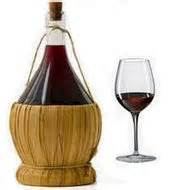I am leaving first thing tomorrow morning for Italy! I’ll be spending a week in Siena with my boyfriend and his family before flying to meet M&D’s very own Andrew Sarubbi for another week traveling Spain and Portugal. I am beyond excited for the food, the wine, and the time off work. Matt and I have been talking about how we want to spend the trip and while we have lots of ideas, one thing stands out the most – vineyard visits. There are over 800 vineyards in the Tuscany region alone so we are not short on options. The house we are staying in is within short driving distance to Chianti region of Tuscany so I know we’ll be heading that direction at some point. We’ve talked vodka and mezcal recently so today, let’s talk wine. Specifically … Chianti. 
As one can assume, Chianti wine is from the Chianti region of Tuscany, Italy. In fact, only wines from this region can properly be called Chianti though you can find wines from other areas using the name. Imitation is the sincerest form of flattery, right? It’s a red wine that dates back to the 13th century made primarily from Sangiovese and Canaiolo red grapes and Trebbiano and Malvasia white grapes. There are now seven “Chianti Zones” that were defined in 1932 by the Dalmasso Commission:
1. Chianti Classico
2. Chianti Montalbano
3. Chianti Colli Fiorentini (Florentine hills)
4. Chianti Rufini
5. Colli Senesi (Siena hills)
6. Colline Pisane (Pisan hills)
7. Colli Aretini (Arezzo hills)
Understanding the zone from which a specific Chianti comes from is helpful, but the best way to determine the quality and history is to know the specific winery or vineyard it was harvested from. Some zones, Chianti Classico for example, include both high quality vineyards as well as substandard vineyards which makes it difficult to come to any clear assumptions before physically tasting the wine itself. Knowing more information about the specific winery can save you some money before purchasing something that isn’t quite up to par.
Speaking of buying wine, let’s get a little more into the typical flavor profile of a Chianti. It’s a strong, bold, red wine often with notes of dark fruits (cherry, plum, and strawberry), spice, vanilla, almond, and tobacco. The fruit flavors tend to stand out the most which makes it a good choice for somebody new to the wine world and it pairs perfectly with well-seasoned foods.
Traditionally, Chianti was served in a basket bottle, as shown in the image above however, these days it’s usually in the more elegant looking glass bottles that we are used to. I’m hoping that I’ll get a taste of tradition and culture on my trip! I’ll be sure to keep you posted … That is, if I decide to come home.
Rebecca McKinney
I wanted to create this blog for a few reasons. First and foremost, to share tips, tricks, and knowledge about the food and beverage industry in general but also to help people see a different side of the restaurant world. Every restaurant has a totally unique culture and world within it. I want to help open people’s eyes to more than how fast the service is or how easy or hard it is to secure a reservation.
So, thanks for stopping by! I welcome your ideas, input, and feedback and hope you enjoy!
Eat well & travel often,
Becky McKinney
Latest posts by Rebecca McKinney (see all)
- Why Food Makes the Best Gift for a New Mom - April 12, 2023
- 5 Ingredients to Cook With This Spring - March 15, 2023
- 10 Reasons to Dine Out on Valentine’s Day - February 2, 2023



Leave a Reply